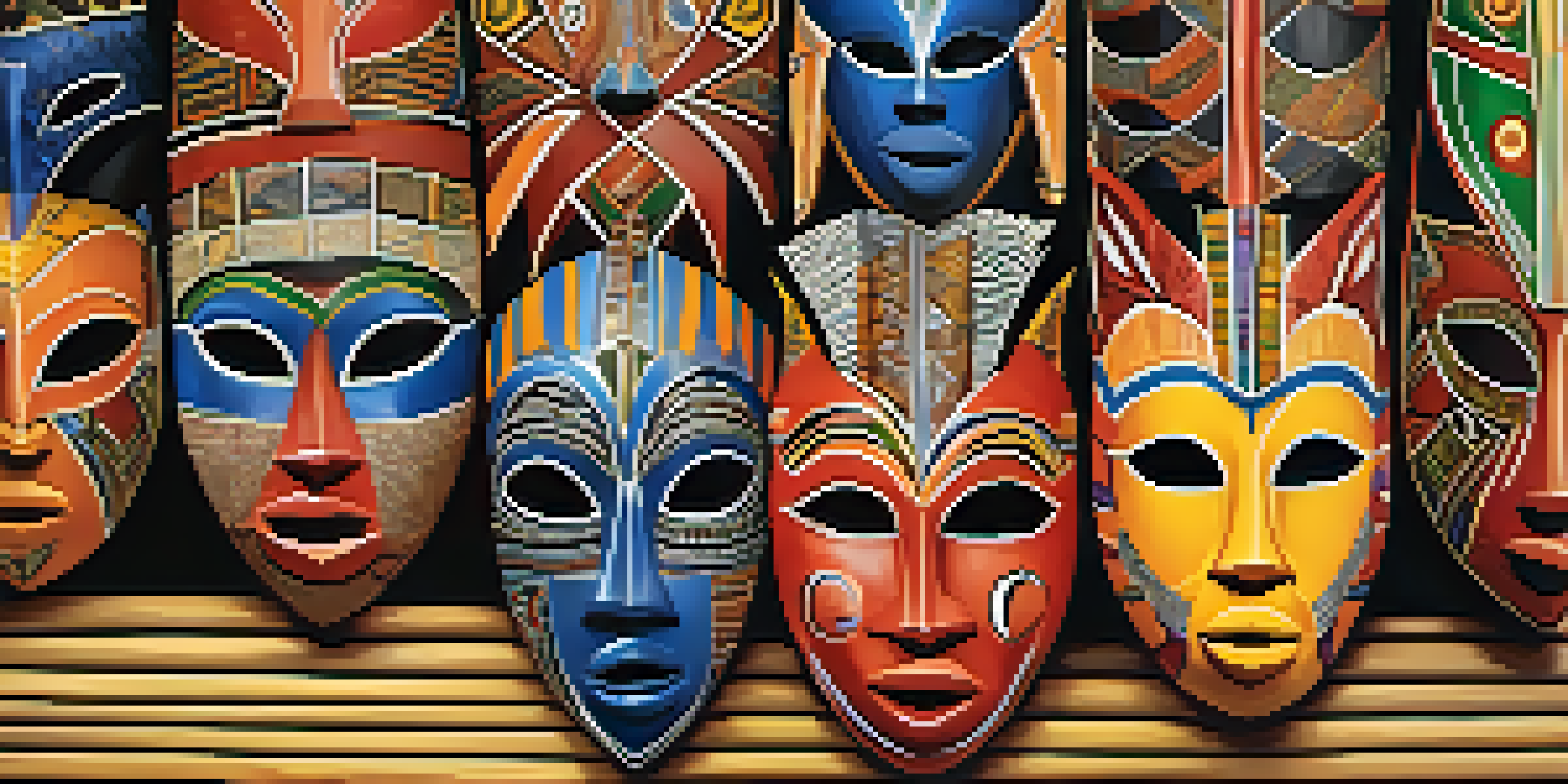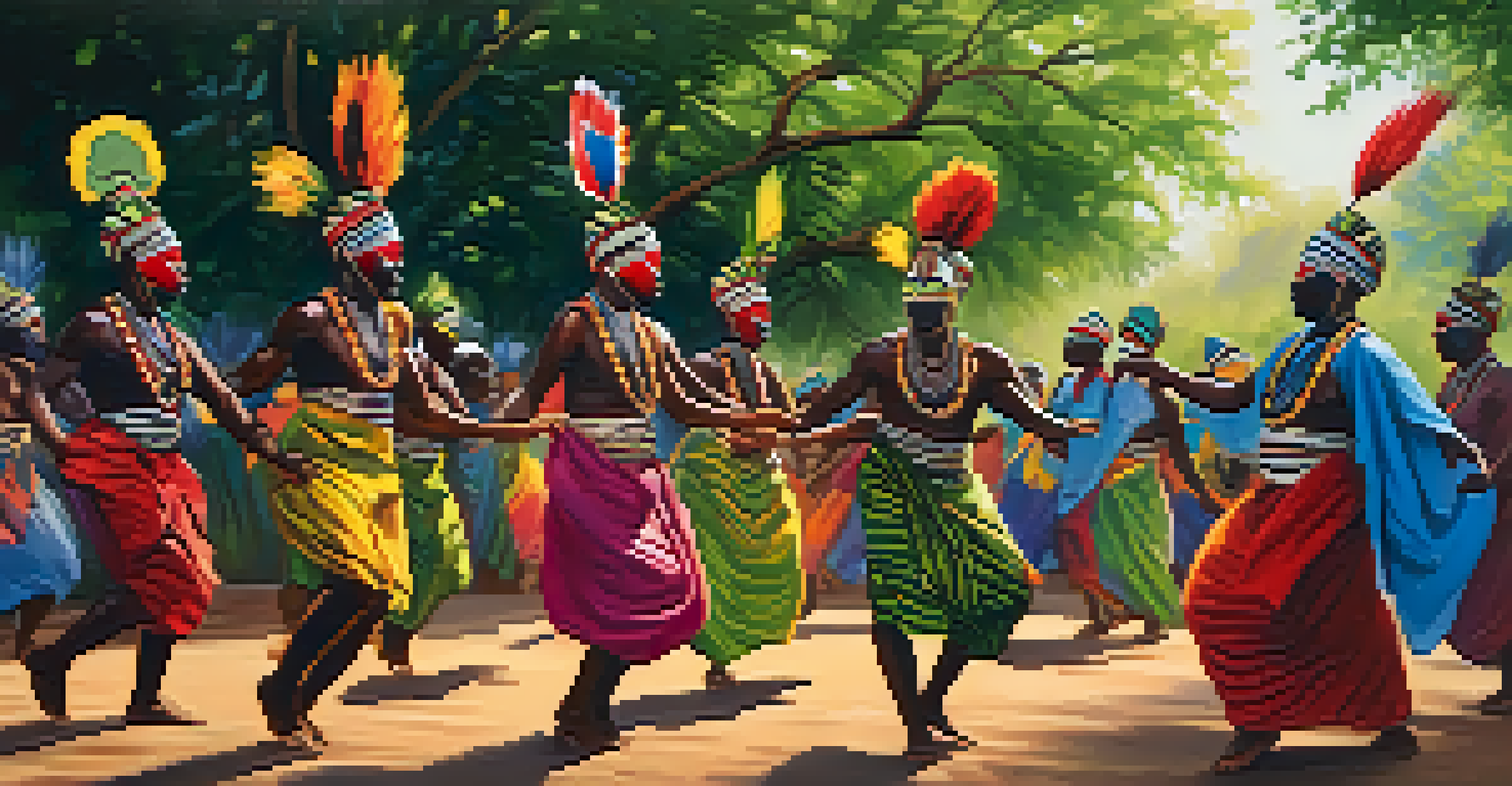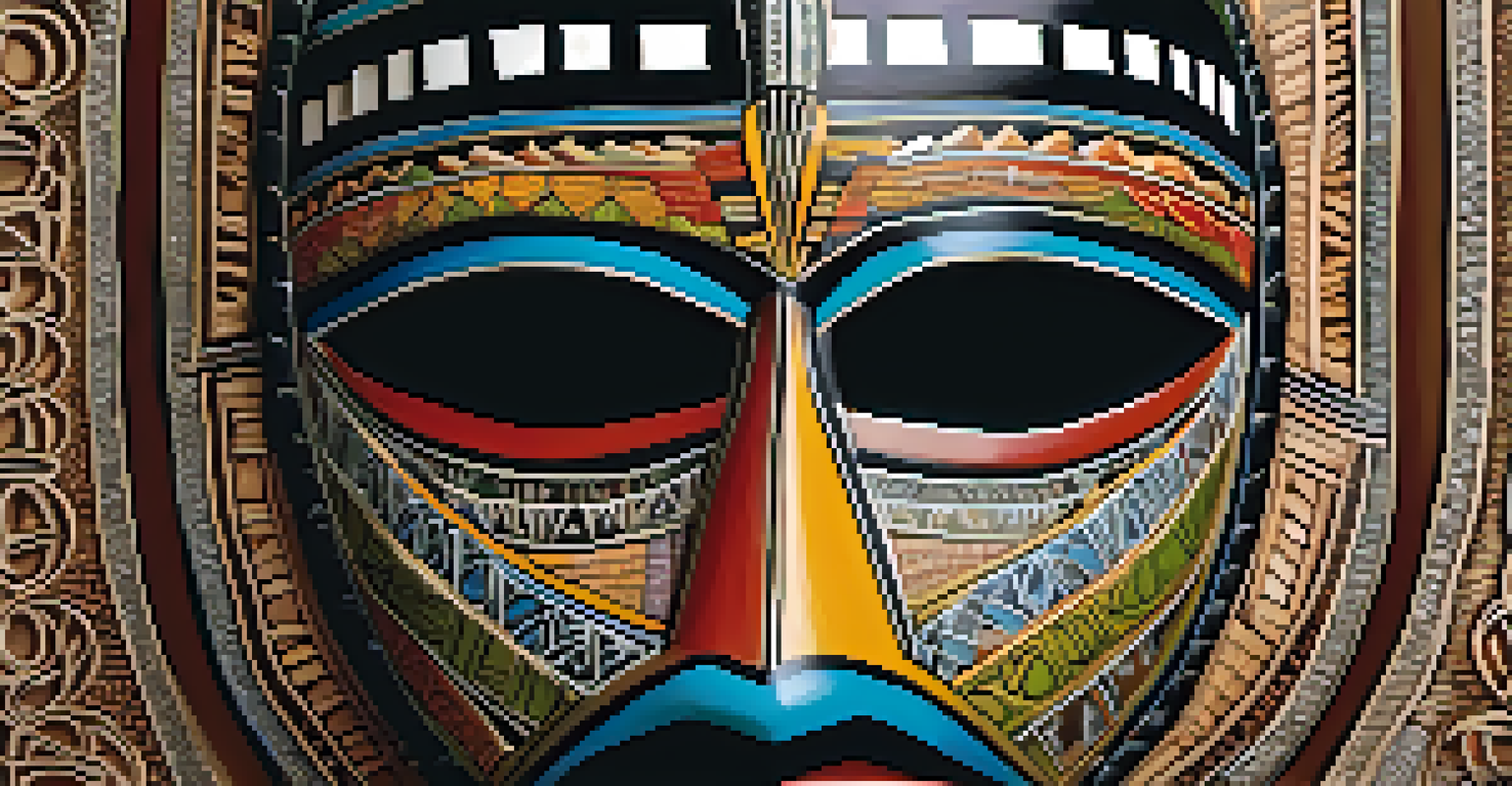African Masks: Art Forms That Tell Stories of Ancestry

Understanding the Cultural Significance of African Masks
African masks are not merely decorative objects; they hold deep cultural significance within various communities. Each mask is often imbued with meaning, symbolizing spiritual beliefs, social status, or ancestral connections. They serve as a bridge between the physical and spiritual worlds, allowing wearers to embody the spirits of ancestors during ceremonies.
The mask is a vehicle of communication between the living and the dead, a bridge that connects the two worlds.
For instance, the Dogon people of Mali create masks that represent their cosmology and connection to the universe. These masks play a pivotal role in rituals and celebrations, showcasing the community's beliefs and values. Through these artistic expressions, they preserve their history and identity, passing down stories from generation to generation.
Moreover, the intricate designs and materials used in creating these masks reflect the artisans' skills and cultural heritage. Each region boasts its unique style, making every mask a distinctive piece of art that tells a story. Thus, understanding these masks is crucial for appreciating the rich tapestry of African cultures.
The Role of Masks in Traditional Ceremonies
Masks are often central to traditional ceremonies and rituals across Africa. They facilitate communication between the living and the spiritual realm, allowing participants to honor ancestors and seek guidance. These events can range from initiation rites to harvest festivals, showcasing the masks' versatility in different cultural contexts.

During such ceremonies, masks are worn by dancers who bring the characters to life, embodying the traits and stories they represent. For example, the Hausa people of Nigeria use masks in their festivals to celebrate fertility and abundance, connecting their agricultural practices with spiritual beliefs. This lively interaction creates a communal experience, reinforcing cultural bonds.
Masks Hold Deep Cultural Meaning
African masks symbolize spiritual beliefs, social status, and ancestral connections, serving as a bridge between the physical and spiritual worlds.
Furthermore, these ceremonies often attract the entire community, fostering a sense of unity and shared identity. By engaging in these rituals, participants not only celebrate their heritage but also educate younger generations about their ancestry. This cyclical process ensures that the stories and values associated with the masks continue to thrive.
Diverse Styles: Regional Variations in Mask Art
The diversity of African masks is astounding, with each region showcasing its unique artistic styles and materials. From the bold, geometric shapes of the Baule masks in Ivory Coast to the elegant, elongated features of the Fang masks from Gabon, each style tells a different story. These variations reflect local traditions, beliefs, and the environment in which the masks were created.
Art is a reflection of society; it tells the stories of its people, their beliefs, and their culture.
For instance, the Yoruba people are known for their vibrant, colorful masks that often portray deities and mythical figures. In contrast, the Maasai of Kenya create more understated masks that emphasize functionality and simplicity. This variety not only highlights the creativity of African artisans but also illustrates the cultural richness across the continent.
Moreover, regional influences can lead to the fusion of styles, creating hybrid forms that enrich the art of mask-making. As artists continue to innovate while honoring their traditions, they contribute to the evolving narrative of African masks, ensuring that their stories remain relevant in contemporary society.
Symbolism and Meaning Behind Mask Designs
Every mask is a canvas that conveys stories through its designs and symbols. The colors, shapes, and materials used often carry specific meanings, reflecting the cultural context from which they originate. For example, black may symbolize the earth, while red often represents blood and sacrifice, speaking to the spiritual beliefs intertwined with the art.
Additionally, certain motifs may illustrate ancestral lineage or community values, making the mask a powerful emblem of identity. The Senufo masks from Côte d'Ivoire, for instance, often feature intricate carvings that tell stories of creation, morality, and the importance of community. This symbolic language transforms each mask into a narrative tool that communicates profound cultural messages.
Diverse Styles Reflect Regional Heritage
Each region in Africa showcases unique artistic styles in mask-making that tell stories reflective of local traditions, beliefs, and environments.
Understanding the symbolism behind these masks enhances our appreciation for their artistry and the stories they tell. It invites us to look beyond the surface and acknowledge the rich histories and traditions that inform these remarkable works of art.
Preservation Efforts: Safeguarding African Mask Heritage
As globalization and modernization threaten traditional practices, preservation efforts for African masks have become increasingly vital. Various organizations and communities are working tirelessly to protect the cultural heritage associated with these masks. Initiatives include documenting traditional mask-making techniques and supporting artisans in their craft.
For example, workshops and training programs help young artisans learn from their elders, ensuring that the skills and knowledge of mask-making are passed down. These efforts not only help maintain cultural practices but also empower communities economically, as unique masks become valuable for collectors and art enthusiasts worldwide.
Moreover, museums and galleries play a crucial role in showcasing African masks, fostering appreciation and dialogue around their significance. By advocating for ethical practices in collecting and displaying these artifacts, they contribute to a more profound understanding of their cultural importance and the narratives they convey.
Contemporary Adaptations of African Masks in Art
In recent years, contemporary artists have begun to reinterpret traditional African masks, blending age-old techniques with modern aesthetics. This fusion creates a dialogue between the past and present, allowing for new expressions of identity and culture. Artists are experimenting with materials, forms, and contexts, pushing the boundaries of what mask art can represent.
For instance, some artists incorporate mixed media or innovative technologies, challenging viewers to reconsider their perceptions of traditional art forms. These adaptations not only celebrate the heritage of African masks but also invite global audiences to engage with and appreciate their significance in new ways.
Preservation Efforts Safeguard Heritage
As globalization threatens traditional practices, organizations and communities are actively working to preserve the cultural heritage of African masks.
Additionally, contemporary adaptations allow for a broader conversation about cultural identity in a globalized world. By reimagining these masks, artists highlight the ongoing relevance of ancestral stories, ensuring that the narratives they convey continue to resonate with audiences today.
The Global Impact of African Masks on Art and Culture
The influence of African masks extends far beyond the continent, impacting global art and culture. Artists, designers, and filmmakers have drawn inspiration from these rich traditions, incorporating elements of African mask aesthetics into their work. This cross-cultural exchange enriches the global artistic landscape and fosters a greater appreciation for the diversity of human expression.
For example, in fashion, designers have embraced African motifs and patterns, celebrating their vibrancy and storytelling potential. Similarly, filmmakers often use masks to symbolize deeper themes of identity, spirituality, and connection to heritage, showcasing the universal relevance of these artifacts.

This global recognition of African masks not only honors their artistic value but also elevates the voices and stories of the communities from which they originate. By embracing these influences, we cultivate a more inclusive understanding of art and culture, reminding us of our shared humanity.